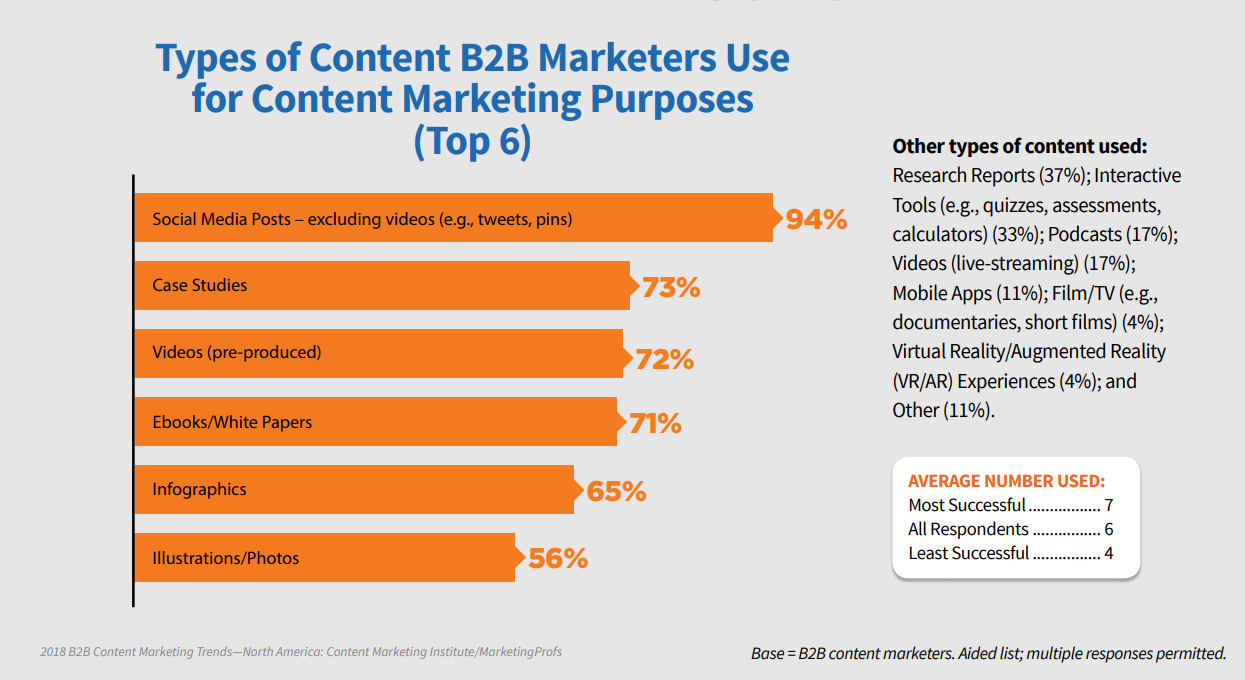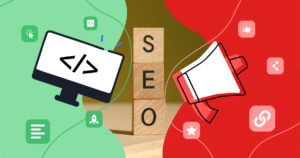Compared to B2C (business-to-consumer) enterprise, operating as a B2B (business-to-business) company demands a much different marketing strategy. Notably, you have to focus on appealing to a number of individuals and decision-makers, not just a single customer.
Sales funnels are longer and more complex, so you need high-quality B2B content writing to captivate leads and nurture them until they’re ready to close.
However, everything about the B2B sales process is unique, including the type of content you produce.
So, even if you’re familiar with B2C materials, you have to adjust your tactics to engage with your B2B clientele.
Fortunately, we’re here to help with this comprehensive guide to content writing for B2B enterprises.
Here is everything you need to know, including how to get high-quality content fast.
- What is B2B Content?
- B2B Content Writing vs. B2C Content
- How to Write Captivating B2B Content
- B2B Writing Samples
- Get Better B2B Content Writing From Rock Content!
What is B2B Content?
The primary goal of B2B content is to produce materials to raise brand awareness and engage with clients for the purpose of establishing your authority within an industry.
Content marketing is a valuable tool because you’re trying to appeal to other businesses, not individual customers.
B2B content is unique because it not only has to establish your knowledge and insight but also engage with multiple people within the same business.
For example, your sales team may need to work with various managers, supervisors, and executives before they can close a deal.
So, you need content that can appeal to each link in the chain.
Overall, B2B content is much broader and goes much deeper than what you would have for B2C.
Thankfully, Rock Content can help you deliver more comprehensive materials to your clients, so you can convert leads and build trust faster.
B2B Content Writing vs. B2C Content
B2C content often appeals to individual emotions and focuses on delivering a compelling and immediate call to action.
In many cases, high-value content is more qualified to convert a lead to a customer with little else to go on. Since the customer is the first and final decision-maker, they can pull the trigger immediately.
By comparison, B2B content is much more time-consuming and must work on multiple levels.
In many cases, you may have different versions of the same content to show to different people within a single organization.
For example, you may have a sales pitch geared toward hourly staff members, then a white paper or a presentation to sell the concept to higher-level management or executives.
Here’s a more in-depth breakdown of the differences you can find between B2C and B2B content:
Emotional vs. Rational
There’s a misconception that B2B customers only think logically, not emotionally. This isn’t exactly true, what is more accurate is that the emotions of a B2B customer are rooted in different reactions and consequences.
For example, a customer may make an impulsive purchase because they’re hungry or the product can help them at that moment.
A B2B client, though, may think about how well the product will impress their bosses.
Both decisions are based on emotion, but what changes is the “next step.”
A customer decides to purchase the item while a B2B client decides to pass marketing materials on to their superior.
Timing
B2C content marketing is much more immediate and can drive specific actions.
Examples of the actions that customers may take include buying an item, signing up for an email list, or calling to find out more information.
Even in the latter two scenarios, the customer can move forward inside the funnel or back out at any time.
With a B2B client, there might be multiple levels of decision-makers, and the timing between each step in the funnel might take days or weeks to move forward.
Overall, closing the deal with a B2C customer could take a few minutes or a couple of days at most.
With B2B, the average sales cycle can last up to four months.
Content Types
Realistically, when working with B2B clients, you’ll need to supply a variety of compelling information about your product and your brand.
If each piece is identical to the last, it’s harder to keep various people engaged and move the needle forward.
Instead, it’s much better to have a variety of content available. Here is a list of some examples of types of content for B2B audiences:
- White Papers – Industry-leading information about a complex topic that your clients will know about (or want to know more about).
- E-Books – An E-book is a comprehensive and informative content piece that takes a deep dive into multi-faceted subjects. When done well, brands can sell E-books or use them as incentives for CTAs.
- Tutorials – Sometimes, you might have to explain your products or services in detail. While a sales presentation can work wonders, tutorial-style content is also excellent as supplemental information. You can produce videos or written tutorials, depending on the subject and the target audience.
- Infographics – These pieces are excellent for different stages of the sales cycle because they’re easy to digest while providing tons of useful information. Typically, infographics are simple enough to be shareable, but they may also be more complicated to appeal to executives and other decision-makers.
Although you can produce this type of content for B2C marketing material too, they’re often a bit too in-depth for the average customer. Instead, blog posts, social media posts, and sales videos can work wonders and allow you to close deals much faster.

Writing Style
As a rule of thumb, B2C companies tend to be more casual and conversational when writing content for their customers.
Because the content has to appeal to a specific demographic, it makes sense to avoid complex language or too many details that could make the materials boring or uninteresting.
With B2B content writing, it’s often better to write professionally and show off your insider knowledge.
Overall, the more authoritative and insightful you are, the more likely you can convince different decision-makers to move forward to the next step.
Relationship Building
When talking with a B2C customer, the goal is to appeal to their pain points with immediate solutions. For example, you’re struggling to keep your house clean? Buy this cleaning solution and get done in half the time!
In many cases, the relationship you build with B2C customers is short-term and focuses on a specific product. While you can build loyalty among your audience with repeat purchases or an expanded product line, the relationship is mostly one-sided.
With B2B companies, you’re trying to build a long-term relationship from the beginning.
Since it may take a few months to close the deal, you need to get to know your clients better so you can figure out how your products or services can help alleviate their pain.
Realistically, you’ll build the most substantial relationship with the first link in the chain. Then, as more decision-makers are brought in, you might have to appeal to them immediately since you may not have a second or third chance to wow them with your pitch.
In many cases, this type of relationship-building leads to interactions and discussions that are not focused on the sales funnel.
How to Write Captivating B2B Content
When producing B2B content, you need to illustrate that you’re highly knowledgeable and experienced within your industry.
So, while an individual piece may focus on surface-level information or insight, you have to back it up with a deeper understanding of what’s going on behind the scenes.
Here are some tips on how to get B2B content writing right the first time:
Use Social Proof Whenever Possible
Recommendations and word-of-mouth are far more valuable in B2B sales than in B2C. So, if you can leverage testimonials from past clients, you’ll have a much easier time appealing to new leads.
Focus on Company-Wide and Individual Benefits
Since your product or service is geared toward an entire company, you don’t necessarily have to appeal to individual pain points. However, if possible, you should incorporate both levels within your content.
For example, let’s say you’re selling customer service software. Individual reps may like it because the software is easy to use and reduces their workload. Executives may appreciate the program because it improves productivity and cuts labor costs.
Utilize Real-World Storytelling
Ideally, you can use information from past clients, but if not, you can create a story based on target market demographics and user avatars. In this case, you’re not just providing a list of features and benefits.
Instead, you’re weaving those features and benefits into a real-world story where those elements delivered quality results.
Highlight the Most Important Information
The first person your content appeals to is rarely the same person making the final decision.
As such, that individual may not read through your content entirely, choosing instead to scan headers and get bite-sized nuggets of information to pass up the chain.
So, you want your writing to be easy to read and digest. Then, if a manager or executive wants to dive deeper into the details, they can do so too.
Make Your Lead’s Job Easier
A common marketing tactic is to offer a small freebie upfront to get your lead’s attention, then have them pay for more valuable information or products.
With B2B content writing, the freebie could be an e-book, an informative video, or a blog post with actionable tips and tricks for your lead to follow.
As long as this content is highly valuable by itself, your lead will be more likely to seek out additional information later.
B2B Writing Samples
Knowing the basic elements of B2B content writing is one thing, but seeing it in action is another.
Here are 3 compelling writing samples that illustrate the different ways for B2B companies to appeal to their clients.
1. Roast My Landing Page
This brand audits your landing page and tells you how to improve it to get more conversions. The B2B sales copy reads:
So many new customers you’ll have to work weekends. Turn more visitors to your Saas, B2B landing page, or lead magnet into customers, and increase revenue and profits. But how? I have 15 years’ hands-on experience increasing landing page conversion. Let me help you.
Roast My Landing Page
This copy is short and to the point while delivering a compelling storytelling narrative. Imagine being so busy that you have to work weekends to handle the sheer volume of traffic. That sounds pretty appealing to any business, and it will make the reader want to click the CTA.
Also, the name of the company, Roast My Landing Page, also sounds unique and quirky without being too casual or unprofessional.
2. Canva
Canva has quickly grown to become the go-to design software for both individuals and companies that don’t want to deal with Adobe Photoshop and Illustrator.
Part of Canva’s appeal is its simplicity, which it gets across in this content copy:
Design made smarter. No matter what “work” means to you, Canva Pro has all the tools you need to design graphics for projects big and small. No design skills necessary: simply drag and drop. Try it free for 30 days.
Canva
This pitch is easy to understand and engages its readers with a simple premise. Plus, a 30-day free trial means there’s no risk to creating an account since the user can cancel at any time.
Also, the language appeals to small and medium-sized businesses that can’t afford an in-house design team.
3. City Pantry
This company does office catering for businesses of all sizes, and it knows the connotations that come with it. So, the content appeals to that misconception immediately and flips the script so the reader knows to expect something better.
Swap office food for good food. We deliver the best restaurants and catering in your city straight to your office. So forget what you know about food at work. Start choosing the food you really want instead. Order now.
At the individual level, employees will appreciate the ability to get better food delivered to the office. At the business level, City Pantry offers affordable pricing and can maximize productivity because workers aren’t traveling outside the building to eat. It’s a win-win situation.
Get Better B2B Content Writing From Rock Content!
Being a B2B company, it is crucial to safeguard your client relationships from being compromised by poor content. Luckily, Rock Content can provide the necessary assistance to prevent such mishaps.
WriterAccess is the ideal platform to help you streamline your content production, combining the efficiency of AI-powered tools with the creativity of human writers.
Why not give it a try today? Enjoy 14 days of free access to our network of expert writers. Discover for yourself what great content can do for your business!










